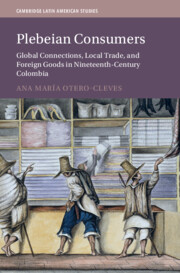 Plebeian Consumers
Plebeian Consumers A Global View on Local Consumption
Published online by Cambridge University Press: 18 December 2024
The introduction sets the stage for a comprehensive exploration of how plebeian consumption shaped global and local interactions in nineteenth-century Colombia, challenging conventional historical narratives and offering new insights into the dynamics of global capitalism and popular citizenship. It does so by providing insight into the existing historiography and its limitations and by highlighting the need to challenge dominant narratives that perpetuate the perception of Latin America and its consumers as passive participants in global transformations. The introduction also explores the methodological challenges of writing histories of consumption “from below” and the need to adopt an interdisciplinary approach drawing from cultural history and anthropology to analyze popular consumption practices. After a historical exploration of Colombia’s place within the global nineteenth century, the introduction concludes with a brief outline of the book’s chapters.
To save this book to your Kindle, first ensure [email protected] is added to your Approved Personal Document E-mail List under your Personal Document Settings on the Manage Your Content and Devices page of your Amazon account. Then enter the ‘name’ part of your Kindle email address below. Find out more about saving to your Kindle.
Note you can select to save to either the @free.kindle.com or @kindle.com variations. ‘@free.kindle.com’ emails are free but can only be saved to your device when it is connected to wi-fi. ‘@kindle.com’ emails can be delivered even when you are not connected to wi-fi, but note that service fees apply.
Find out more about the Kindle Personal Document Service.
To save content items to your account, please confirm that you agree to abide by our usage policies. If this is the first time you use this feature, you will be asked to authorise Cambridge Core to connect with your account. Find out more about saving content to Dropbox.
To save content items to your account, please confirm that you agree to abide by our usage policies. If this is the first time you use this feature, you will be asked to authorise Cambridge Core to connect with your account. Find out more about saving content to Google Drive.